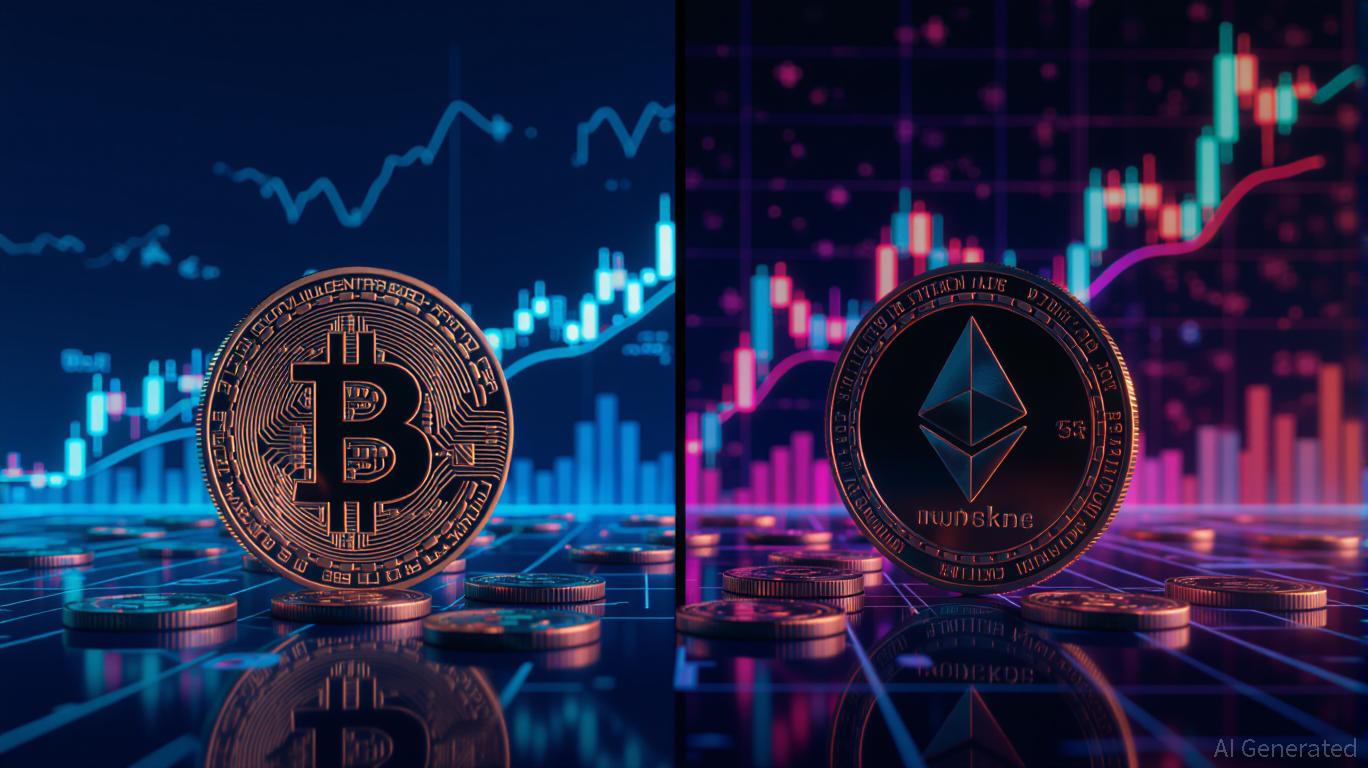Strategic Public-Private Partnerships: Unlocking Africa's Digital Inclusion and Telecom Growth
- Africa's digital transformation accelerates through public-private partnerships (PPPs), bridging the 60% internet access gap via open-source platforms like MOSIP. - Modular systems (e.g., Ghana's GIP, Uganda's UGHub) reduce costs by 30-40%, enabling cross-border interoperability aligned with AU's 2030 digital strategy. - Telecom leaders like MTN and Safaricom demonstrate scalable returns, with M-Pesa serving 50M users and MTN's stock rising 22% in 2025. - Global initiatives (50-in-5, UPI adoption) and Af
In the vast, sun-scorched landscapes of Africa, a quiet revolution is unfolding. The continent, long plagued by a digital divide, is witnessing a surge in internet infrastructure driven by innovative public-private partnerships (PPPs). These collaborations are not merely technical exercises but strategic alliances that promise to transform economies, empower communities, and unlock unprecedented investment opportunities. For investors, the question is no longer whether Africa's digital future is viable but how to position capital to benefit from its rapid evolution.
The challenge of expanding internet access in Africa is formidable. Over 60% of the population remains offline, with rural areas and informal settlements like Nairobi's Kibera facing the most acute gaps. Yet, the solutions emerging from PPPs are as creative as they are scalable. Take the Modular Open-Source Identity Platform (MOSIP), an open-source digital ID system inspired by India's Aadhaar. Deployed in nine African nations, MOSIP reduces implementation costs by 40% compared to proprietary systems, enabling governments to build interoperable digital ecosystems. This is not just about IDs; it's about creating a foundation for digital payments, e-governance, and financial inclusion.
The success of these models lies in their ability to leverage existing infrastructure. For instance, Ghana's GHIPSS Instant Payment System (GIP) and Uganda's UGHub data exchange platform demonstrate how modular, open-source systems can be adapted to local needs. These platforms, developed with private-sector expertise and public-sector oversight, have slashed transaction costs and expanded access to financial services for millions. Investors should note that such systems are not isolated experiments but part of a broader trend: the African Union's Digital Transformation Strategy (2020–2030) aims to harmonize digital frameworks across 55 nations, creating a unified market for telecom and fintech innovation.
Consider MTN Group, Africa's largest mobile operator. Its partnerships with governments to deploy 4G networks in rural areas have not only expanded connectivity but also driven revenue growth. MTN's stock has appreciated by 22% in the last year, reflecting investor confidence in its role as a PPP enabler. Similarly, Safaricom's M-Pesa mobile money platform, which now serves 50 million users, has become a cornerstone of Kenya's digital economy. These companies exemplify how telecom firms can scale infrastructure while generating sustainable returns.
Yet, the most compelling opportunities lie in the intersection of technology and governance. The 50-in-5 campaign, a pan-African initiative to deploy digital public infrastructure (DPI) in 50 countries by 2028, is attracting global partners like India's UPI and the World Bank. By adopting proven technologies and open standards, African nations are avoiding the costly pitfalls of bespoke systems. For instance, Namibia's adoption of UPI for real-time payments has reduced transaction fees by 30%, while Rwanda's alignment with the Digital Public Goods (DPG) Charter has accelerated local tech ecosystems.
Investors must also consider the regulatory landscape. The African Union's Malabo Convention on Cybersecurity and Personal Data Protection is a double-edged sword: it ensures privacy but also creates compliance hurdles. However, countries that harmonize their frameworks—like Ghana and Tanzania with their interoperable payment systems—will attract more capital. The MSCI Africa Information Technology Index, which has outperformed global peers by 15% in 2025, underscores the sector's resilience.
For those seeking high-impact, sustainable growth, the path is clear. Prioritize companies and funds that:
1. Leverage open-source platforms (e.g., MOSIP, UGHub) to reduce costs and accelerate deployment.
2. Partner with governments to access subsidies and regulatory support, as seen in Congo's telecom PPPs.
3. Focus on cross-border interoperability, aligning with AU frameworks to tap into the AfCFTA's $3 trillion market.
Risks remain, of course. Political instability and underdeveloped regulatory environments can derail projects. But for investors with a long-term horizon, the rewards are substantial. Africa's digital transformation is not a speculative bet—it is a calculated, data-driven opportunity to build infrastructure that will underpin the continent's next decade of growth.
In the end, the lesson from Africa's PPPs is universal: the most transformative investments are those that bridge the gap between public ambition and private innovation. As the continent's digital networks expand, so too will the fortunes of those who recognize the power of strategic collaboration.
Disclaimer: The content of this article solely reflects the author's opinion and does not represent the platform in any capacity. This article is not intended to serve as a reference for making investment decisions.
You may also like
Metaplanet's $1.2B Bitcoin Treasury Expansion: A Strategic Hedge Against Yen Weakness and Inflation
- Metaplanet raises $1.2B to expand Bitcoin treasury, hedging against yen depreciation and Japan's 4% inflation. - Aims to hold 210,000 BTC by 2027, becoming Asia's largest holder and fourth globally. - Generates income via covered call options, boosting Q2 2025 sales to 1.9B yen. - Regulatory reforms and institutional confidence boost its FTSE Russell index inclusion. - Strategy highlights Bitcoin's role as a corporate reserve asset amid fiat instability.

MAGACOIN FINANCE: The 2025 Presale Powerhouse Outperforming Bitcoin and LINK
- MAGACOIN FINANCE emerges as a 2025 crypto contender with deflationary mechanics, presale scarcity, and institutional-grade infrastructure. - $1.4B whale inflows and dual 100/100 security audits validate its institutional credibility, outpacing Ethereum and Chainlink whale activity. - A 12% transaction burn rate and 170B token hard cap create scarcity-driven demand, contrasting inflationary models like Cardano or meme coins. - With 88% presale sold and a 25,000x ROI projection, it challenges Bitcoin's lin

Ethereum's Scarcity-Driven Institutional Takeover: How BitMine's $20 Billion Raise Is Reshaping Crypto Valuation Models
- BitMine Immersion (BMNR) raised $20B to accumulate 6M ETH, engineering scarcity and redefining institutional valuation models. - Ethereum’s deflationary supply, driven by EIP-1559 burns and BitMine’s 190,500 ETH/week purchases, amplifies scarcity and institutional confidence. - Institutional adoption accelerates with Ethereum ETFs attracting $9.4B in Q2 2025, outpacing Bitcoin, as 51% of stablecoin markets rely on Ethereum. - BitMine’s NAV surged 74% in three months, leveraging Ethereum’s yield and staki

DeFi Presales: The High-Growth Alternative to Stagnant Blue-Chip Crypto?
- 2025 crypto market shows stark divergence: blue-chip BTC/ETH offer stability while DeFi presales deliver explosive ROI potential. - Bitcoin hits $108k all-time high but lags Ethereum's 114.8% annual ROI, contrasting DeFi tokens' 2,400%-5,000% projected gains. - DeFi projects like Bitcoin Hyper ($HYPER) and Wall Street Pepe ($WEPE) leverage AI, cross-chain tech, and deflationary models to attract speculative capital. - High-risk DeFi presales face execution risks and regulatory uncertainty, while blue-chi
